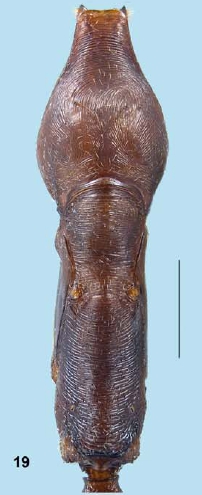Odontomachus scifictus
| Odontomachus scifictus | |
|---|---|

| |
| Scientific classification | |
| Kingdom: | Animalia |
| Phylum: | Arthropoda |
| Class: | Insecta |
| Order: | Hymenoptera |
| Family: | Formicidae |
| Subfamily: | Ponerinae |
| Tribe: | Ponerini |
| Genus: | Odontomachus |
| Species: | O. scifictus |
| Binomial name | |
| Odontomachus scifictus Sorger & Zettel, 2011 | |
Collected in shaded, humid places mostly in degraded, dipterocarp forests. The type locality was near a stream.
Identification
Sorger & Zettel (2011) - A member of the Odontomachus infandus group. Odontomachus scifictus is very similar to Odontomachus philippinus, but differs in the extension of the smooth area on the mesopleuron reaching the meso-metapleural suture, and by the distinct tubercles of the petiole (petiole in anterodorsal aspect widest at tubercles). The distribution of O. scifictusand O. philippinus are separated by another vicariant form, Odontomachus alius.
Keys including this Species
Distribution
Endemic to the Philippines and only known from the island of Camiguin.
Distribution based on Regional Taxon Lists
Indo-Australian Region: Philippines (type locality).
Distribution based on AntMaps
Distribution based on AntWeb specimens
Check data from AntWeb
Countries Occupied
| Number of countries occupied by this species based on AntWiki Regional Taxon Lists. In general, fewer countries occupied indicates a narrower range, while more countries indicates a more widespread species. |

|
Estimated Abundance
| Relative abundance based on number of AntMaps records per species (this species within the purple bar). Fewer records (to the left) indicates a less abundant/encountered species while more records (to the right) indicates more abundant/encountered species. |

|
Biology
Castes
Worker
  
| |
| . | |
Nomenclature
The following information is derived from Barry Bolton's Online Catalogue of the Ants of the World.
- scifictus. Odontomachus scifictus Sorger & Zettel, 2011: 154, figs. 7, 13, 19, 46 (w.) PHILIPPINES (Camiguin I.).
- Type-material: holotype worker, 70 paratype workers.
- Type-locality: holotype Philippines: Camiguin, W Mambajao, Katibawasan spring area, 350-400 m., 13 and 15.iii.2010 (H. Zettel & C.V. Pangantihon); paratypes: 65 workers with same data, 1 worker W Mambanjao, Benon, Saran-Kampanan, 500-800 m., 16 and 18.iii.2010 (H. Zettel & C.V. Pangantihon), 1 worker Mambajao, Yumbing, 28.x.2008 (C.V. Pangantihon), 3 workers Catarman, Mainit, Tuasan Falls, 23.x.2008 (C.V. Pangantihon).
- Type-depositories: USCC (holotype); DMSC, HSZC, NHMW, UPLB, USCC (paratypes).
- Distribution: Philippines (Camiguin).
Unless otherwise noted the text for the remainder of this section is reported from the publication that includes the original description.
Description
Worker
Measurements: holotype worker: CI 70, HL 3.32, HW 2.33, MdI 60, MdL 2.00, MsL 4.47, PnW 1.38, PtH 1.36, PtL 1.48, PtW 0.50, SI 141, SL 3.28, TL 14.50; paratype worker with smallest HW: CI 67, HL 2.93, HW 1.97, MdI 54, MdL 1.58, MsL 3.80, PnW 1.18, PtH 1.15, PtL 1.28, PtW 0.42, SI 151, SL 2.97, TL 12.63; paratype worker with largest HW: CI 71, HL 3.42, HW 2.42, MdI 59, MdL 2.00, MsL 4.80, SI 139, SL 3.37, PnW 1.43, PtH 1.38, PtL 1.60, PtW 0.52, TL 15.25.
Structures: Striation on head extending from frontal lobes to ocular ridge, rest of head smooth and shiny. Pronotum with fine, roughly round striation, closed circles or loops clearly visible in dorsal view; posterolateral parts without striation, smooth and shiny. Mesopleuron smooth and shiny, some fine transverse striation may occur to varying extent but always at least the central region smooth and shiny. S-shaped, long and acute petiolar spine, slightly bent backwards. Entire ant appearing very shiny / glossy.
Pilosity: Pubescence sparse, short.
Colour: Uniformly reddish brown.
Type Material
Camiguin Island, municipality of Mambajao, W of Mambajao, near spring of Katibawasan, ca. 350-400 m a.s.l. Holotype worker (University of San Carlos Entomological Collection): Camiguin: W Mambajao, Katibawasan spring area, 350-400 m, 13. and 15.III.2010, leg. H. Zettel & C. V. Pangantihon (515). Paratypes (70 workers; CSW, Herbert and S.V. Zettel, Naturhistorisches Museum Wien, Vienna, University of the Philippines Los Baños, USC): same locality data as holotype, 65 workers. W Mambajao, Benon, Saran – Kampanan, 500-800 m, 16. and 18.III. 2010, leg. H. Zettel & C. V. Pangantihon (516), 1 worker. Mambajao, Yumbing, 28.X.2008, leg. C. V. Pangantihon (P306), 1 worker. Catarman, Mainit, Tuasan Falls, 23.X.2008, leg. C. V. Pangantihon (P302), 3 workers.
Etymology
This name serves as an homage to early science fiction movies incorporating ants – the first author came across a poster of the movie “Empire of the Ants” (1977) directed by Bert I. Gordon that clearly depicts a giant, dangerously looking Odontomachus species and decided that such prominent display should be memorialized.

